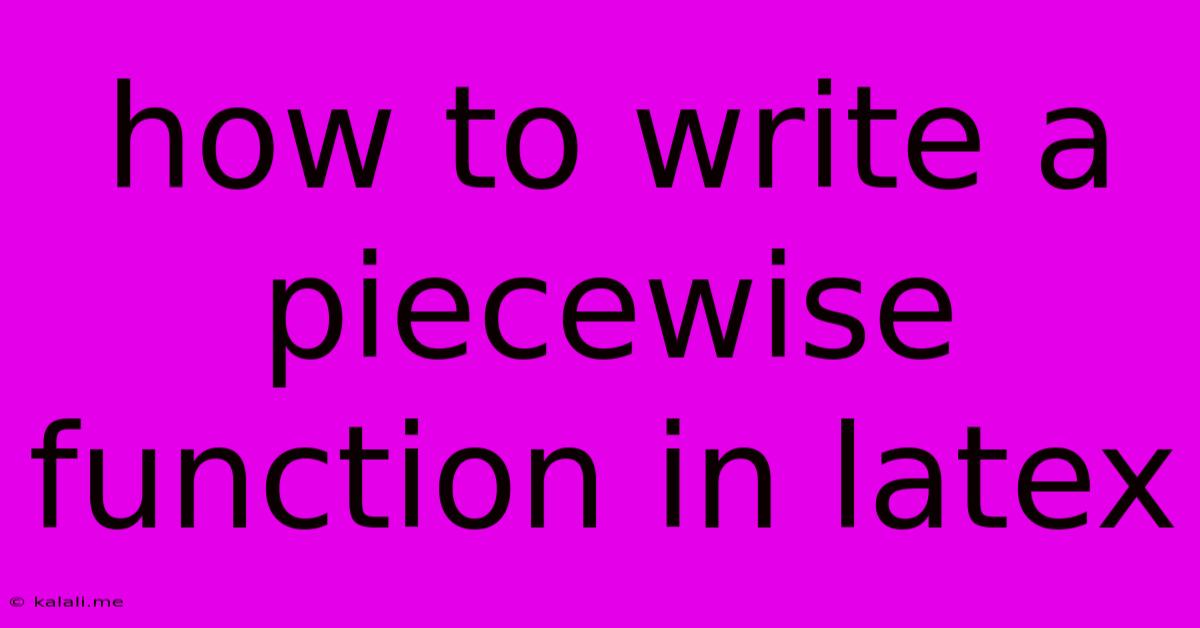How To Write A Piecewise Function In Latex
Kalali
May 25, 2025 · 3 min read

Table of Contents
How to Write a Piecewise Function in LaTeX: A Comprehensive Guide
This guide provides a comprehensive walkthrough on how to write piecewise functions in LaTeX, covering various styles and complexities. Piecewise functions, which define different outputs based on input ranges, are commonly used in mathematics and require specific formatting in LaTeX for clarity and readability. This guide will show you how to achieve this effectively, enhancing both the visual appeal and the understandability of your mathematical expressions.
Understanding Piecewise Functions
Before diving into LaTeX, let's briefly recap what piecewise functions are. They are functions defined by multiple sub-functions, each applicable over a specified interval or condition. For instance, a function might have one formula for positive inputs and another for negative inputs. LaTeX offers the tools to represent these different parts neatly and logically.
Basic Piecewise Function in LaTeX
The most straightforward method uses the cases environment from the amsmath package. This package is essential for advanced mathematical typesetting in LaTeX and needs to be included in your preamble:
\usepackage{amsmath}
The basic structure of a piecewise function within the cases environment is as follows:
f(x) = \begin{cases}
expression_1 & condition_1 \\
expression_2 & condition_2 \\
expression_3 & condition_3 \\
\end{cases}
Let's create a simple example:
f(x) = \begin{cases}
x^2 & x > 0 \\
0 & x = 0 \\
-x & x < 0
\end{cases}
This will render a piecewise function where the function's output depends on whether x is positive, zero, or negative.
Advanced Techniques and Styling
While the basic structure works well, we can enhance the visual presentation and handle more complex scenarios.
Using aligned environment for complex expressions:
If your expressions are lengthy or involve multiple terms, you might find the aligned environment within the cases environment helpful. This allows for better alignment of equal signs and operators within each case.
f(x) = \begin{cases}
\begin{aligned}
x^2 + 2x + 1 \\
\end{aligned} & x > 0 \\
0 & x = 0 \\
\begin{aligned}
-x + \frac{1}{x}
\end{aligned} & x < 0
\end{cases}
Handling Multiple Conditions:
You can easily extend the cases environment to handle functions with multiple conditions.
f(x) = \begin{cases}
x^2 & 0 < x \le 1 \\
x & 1 < x \le 2 \\
0 & x > 2
\end{cases}
Customizing the delimiters:
Although curly braces {} are commonly used, you can alter the delimiters (the brackets encompassing the piecewise definition) to your preference using \left and \right commands along with custom brackets.
Troubleshooting and Common Errors
- Missing
amsmathpackage: Ensure you include\usepackage{amsmath}in your preamble. This is crucial for thecasesenvironment to function correctly. - Incorrect syntax: Double-check your curly braces
{}and ampersands&for proper alignment and separation of expressions and conditions. A missing or misplaced character can lead to compilation errors. - Overly complex expressions: For exceptionally long or intricate expressions, consider breaking them down into smaller, more manageable parts for clarity.
This guide provides a robust foundation for creating piecewise functions in LaTeX. By mastering these techniques, you can create clear, professional-looking mathematical documents that are easily understood by both you and your readers. Remember to always prioritize clarity and readability in your mathematical typesetting.
Latest Posts
Latest Posts
-
If Your 35 What Year Was You Born
Jul 12, 2025
-
How Many Cups Is 1 Pound Of Cheese
Jul 12, 2025
-
30 X 30 Is How Many Square Feet
Jul 12, 2025
-
How Much Does A Half Oz Weigh
Jul 12, 2025
-
Calories In An Omelette With 3 Eggs
Jul 12, 2025
Related Post
Thank you for visiting our website which covers about How To Write A Piecewise Function In Latex . We hope the information provided has been useful to you. Feel free to contact us if you have any questions or need further assistance. See you next time and don't miss to bookmark.